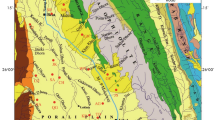Abstract
Five soil samples collected from shooting ranges in 1998 were stored under a closed condition for 5 years. In addition to SEM and XRD investigations, the total organic carbon content (TOC), inorganic carbon content (TIC), δ13C and δ18O of carbonates and δ13C of plant remains were analyzed. The concentrations of total carbon contents, the sum of TOC and TIC, remained the same within the 5 years storage, whereas the TOC and TIC contents decreased and increased, respectively. The TIC increase is associated with a decreased TOC, suggesting a conversion of organic carbon into inorganic carbon. Such a conversion is evidenced by the presence of primary lead carbonates and carbon isotopic composition of lead carbonates. It can be concluded that soil organic matters play an important role in the process of bullets weathering and controls migration of the elevated lead in the soil.



Similar content being viewed by others
References
Adriano DC, Wenzel WW, Vangronsveld J, Bolan NS (2006) Role of assisted natural remediation in environmental cleanup. Geoderma 122:121–142
Astrup T, Boddum JK, Christensen TH (1999) Lead distribution and mobility in a soil embankment used as a bullet stop at a shooting range. J Soil Contam 8:653–665
Cao XD, Dermatas D (2008) Evaluating the applicability of regulatory leaching tests for assessing lead leachability in contaminated shooting range soils. Environ Monit Assess 139(1–3):1–13
Cao XD, Ma LQ, Chen M, Hardison DW Jr, Harris WG (2003a) Lead transformation and distribution in the soils of shooting ranges in Florida, USA. Sci Total Environ 307(1–3):179–189
Cao XD, Ma LQ, Hardison DW Jr, Harris WG (2003b) Weathering of lead bullets and their environmental effects at outdoor shooting ranges. J Environ Qual 32:526–534
Cao XD, Wahbi A, Ma L, Li B, Yang YL (2009) Immobilization of Zn, Cu, and Pb in contaminated soils using phosphate rock and phosphoric acid. J Hazard Mater 164(2–3):555–564
Chaney, RL, Mielke, HW, Sterrett SB (1988) Speciation, mobility and bioavailability of soils lead. In Davies BE, Wixon BG (eds) Lead in Soils: Issues and Guidelines. Supplement to Vol 9 (1989) of Environmental Geochemistry and Health. pp 105–129
Chen M, Daroub SH, Ma LQ, Harris WG, Cao XD (2002) Characterization of lead in soils of a rifle/pistol shooting range in Central Florida, USA. Soil Sediment Contam 11(1):1–17
DeMichele SJ (1984) Nutrition of lead. Comp Biochem Physiol Part A Physiol 78(3):401–408
Dermatas D, Chrysochoou M (2007) Lead particle size and its association with firing conditions and range maintenance: implications for treatment. Environ Geochem Health 29(4):347–355
Dermatas D, Shen G, Chrysochoou M, Grubb DG, Menounou N, Dutko P (2007) Pb speciation versus TCLP release in army firing range soils. J Hazard Mater 136(1):34–46
Hardison DW Jr, Ma LQ, Luongo T, Harris WG (2004) Lead contamination in shooting range soils from abrasion of lead bullets and subsequent weathering. Sci Total Environ 328(1–3):175–183
Jorgensen SS, Willems M (1987) The fate of lead in soils: the transformation of lead pellets in shooting range soils. Ambio 16:11–15
Keeling CD (1958) The concentration and isotopic abundances of atmospheric carbon dioxide in rural areas. Cosmochim de Geochim Acta 13(4):322–334
Kim C, Lee Y, Ong SK (2003) Factors affecting EDTA extraction of lead from lead-contaminated soils. Chemosphere 51(9):845–853
Krishnamurthy S (1992) Extraction and recovery of lead species from soil. Environ Prog 11:256–260
Lin Z (1996) Secondary mineral phases of metallic lead in soils of shooting ranges from Orebro County, Sweden. Environ Geol 27:370–375
Lin Z, Comet B, Qvarfort U, Herbert R (1995) The chemical and mineralogical behavior of Pb in shooting range soils from Central Sweden. Environ Pollut 89(3):303–309
Ma LQ, Hardison DW Jr, Harris WG, Cao XD, Zhou QX (2007) Effects of soil property and soil amendment on weathering of abraded metallic Pb in shooting ranges. Water Air Soil Pollut 178(1–4):297–307
Martin JM, Guan DM, Elbaz-Poulichet F, Thomas A, Gordeev VV (1993) Preliminary assessment of the distributions of some trace elements (As, Cd, Cu, Fe, Ni, Pb and Zn) in a pristine aquatic environment: the Lena river estuary (Russia). Mar Chem 43:185–200
Martin WA, Larson SL, Felt DR, Wright J, Griggs CS, Thompson M, Conca JL, Nestler CC (2008) The effects of organics on lead sorption onto Apatite II™. Appl Geochem 23(1):34–43
Nordt, LC, Wilding, LP, Hallmark, CT, Jacob, JS (1996) Stable carbon isotope composition of pedogenic carbonates and their use in studying pedogenesis. In: Boutton TW, Yamasaki S (eds) Mass spectrometry of soils. Marcel Dekker, New York, pp 133–154
Rietveld HM (1969) A profile refinement method for nuclear and magnetic structures. J Appl Crystallogr 2(1):65–71
Rooney CP, McLaren RG, Condron LM (2007) Control of lead solubility in soil contaminated with lead shot: effect of soil pH. Environ Pollut 149(2):149–157
Scheuhammer AM, Beyer WN, Schmitt CJ (2008) Ecotoxicology: lead. In: Jorenson SE, Fath BD (eds) Encyclopedia of ecology, vol 3. Elsevier, Oxford, pp 2133–2139
Sporting Arms and Ammunition Manufacturers’ Institute (SAAMI) (1996) Lead mobility at shooting ranges. Newtown, CT 06470. Sporting Arms and Ammunition Manufacturers’ Institute, Inc. Facility Development Series, No.1
Stumm W, Morgan JJ (1970) Aquatic chemistry: an introduction emphasizing chemical equilibria in natural waters. Wiley, New York, pp 321–327
Acknowledgments
Dr. ZG Song from Guangzhou Institute of Geochemistry at Chinese Academy of Sciences helped measure the contents of various kinds of carbon. This study was supported by Chinese Academy of Sciences as “100-Talent” program in 2006–2009 and partially funded by the New Jersey Department for Environmental Protection (NJDEP) of USA.
Author information
Authors and Affiliations
Corresponding author
Rights and permissions
About this article
Cite this article
Zheng, G., Xu, S., Liang, M. et al. Transformations of organic carbon and its impact on lead weathering in shooting range soils. Environ Earth Sci 64, 2241–2246 (2011). https://doi.org/10.1007/s12665-011-1052-6
Received:
Accepted:
Published:
Issue Date:
DOI: https://doi.org/10.1007/s12665-011-1052-6




